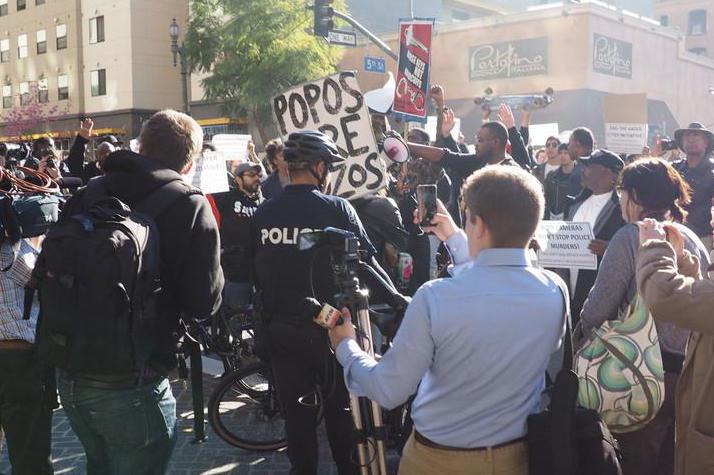The violence that marked the last week in America obscured the fact that it could have been worse: We could have remained completely unaware of how Alton Sterling and Philando Castile died at the hands of police, and we likely would have if not for the presence of camera phones.
By now it’s clear that the increasingly common phenomenon of bystanders filming cops hasn’t ended police wrongdoing altogether, but it can be an important part of keeping law enforcement accountable. Videos of cops assaulting people of color are often used by Black Lives Matter activists to demonstrate the horrors of institutional racism, but the practice of filming the cops stretches across ideological lines. If you are an American concerned that the police might be overstepping their authority, or violating somebody’s rights, you can and probably should take out your phone.
Videos by VICE
Most cops are professional, conscientious individuals, and documenting their interactions can be a dull project. But if you do capture an egregious case of misconduct, your video may become vitally important. Here are some tips for making it the best it can be:
What Kind of Camera Should You Use?

The bottom of the author’s iPhone homescreen
Smartphones are what make widespread cop-watching possible. The default camera apps for Android and iOS are fine. In fact, the iPhone one is ideal if you need to start filming quickly. One tip: A lot of people don’t know you can access the camera extra-extra fast from your lock screen by getting your thumb on the little camera icon at the bottom right corner and swiping up. Try that right now if you don’t already know what I mean.
If you plan to film cops often, you might want to upgrade your software. The Mobile Justice apps created by the American Civil Liberties Union allow you to send your video to local civil rights experts who know the laws and intricacies involved in what you’re witnessing. Your video will be in the cloud and on its way to the ACLU before you’re even done recording, which protects your footage from being deleted should the cops get ahold of your phone.
You can also stream directly to Facebook Live, as Diamond Reynolds did after a Minnesota cop shot her boyfriend, Philando Castile. Her footage was online instantly—but it disappeared for about an hour due to a “technical glitch,” Facebook later said. (The restored video has a disclaimer at the beginning.) If you don’t trust Facebook with your footage, and aren’t sure you want to take the step of sending it to the ACLU, you can also protect your footage by encrypting your phone.
Where Can You Film?
You can stand on public property and film whatever you want, all you want, according to Jay Stanley, a senior policy analyst at the ACLU. “You have a right to take photographs if you’re in a public place, of things that are in plain view, including police officers who are carrying out their duties in public,” he told VICE. “Pretty much no court has found that you have a reasonable expectation of privacy if you’re a police officer in public.”
The question of whether the First Amendment provides a right to film police is not entirely settled—a federal judge recently ruled that it did not, a decision that the ACLU is appealing—but filming the cops is legal everywhere.
There have been some cases, however, where cops who were caught behaving badly on camera attempted to delete the footage or even threatened the amateur documentarians. Its legality aside, filming law enforcement can be an act that carries with it some risk. Which brings us to the most important part:
How Should You Act While Filming?
Taking out a camera and pointing it a cop invites scrutiny from the officers involved, if not an outright argument. Fortunately, you can take a few additional steps to make absolutely certain you’re in the right.
First, don’t stand on private property—not even in a publicly available parking lot, because if a hostile cop wants to call that trespassing, he just might.
Second, be open about what you’re doing. An appeals court has ruled that recording the cops openly is protected by the First Amendment, but secretly filming the police might result in charges for wiretapping in some states, like Massachusetts.
You should cooperate with reasonable requests, such as if a cop asks you to take a couple steps back, and never interfere directly with the situation you’re filming.
Finally, remember that you might still get arrested. “Even if you are legally correct, you have to decide whether you’re willing to face risk, in order to stand up for your rights,” Stanley said.
The below video shows how some cops will attempt to discourage people from filming, with a variety of strategies:
“I recommend that you politely remind the police officer that you have a constitutional right to engage in photography in a public place, and continue recording,” Stanley said.
How you carry yourself is also important. While you should hold your phone out in front of you, try not to jab it way out like a gun. (The reasons for this should be obvious.) In order to look less confrontational, Steve Silverman, the executive director of the nonprofit group Flex Your Rights, recommends filming from your waist, while holding your phone with both hands in landscape mode, a.k.a. horizontally. It’s a nice stable pose, and it formats your footage for viewing on most screens.
How Can You Make Sure Your Footage Is Good?
In the video of the notorious 2015 Texas pool party police brawl (above), the cop doesn’t draw his gun until about three minutes and 15 seconds into the video. “Start as early as you can,” Stanley said, “and keep it going until any possible after effects that might shed any light on the situation are well over with.” In other words, don’t wait for things to escalate, or for a gun to come out—the context before those moments is often incredibly important. Film whatever cops are doing, be it a traffic stop, a street stop-and-frisk, or a drunk driving arrest.
Stanley also suggested that you “narrate what you’re seeing as you’re seeing it,” because that can help the viewer understand what’s happening if what he or she is seeing looks a little confusing. It can also help you remember what was going on in your own video if you find yourself needing to return to footage you’ve had on your phone for a while.
If there’s time, try and get a good angle, one that gives the viewer “a close focus on something, but a broader view of what’s going on,” as Stanley put it.
Lastly, keep in mind that while your footage may provide a key perspective of an event, it’s just that—one perspective. “Cameras can miss things just like humans can miss things,” Stanley said. And cameras are unable to capture certain aspects of an encounter, like whether the suspect has history with police or the type of crime they’re investigating. Still, as the country has learned in the past few years, without video we often have no idea what happened in crucial moments that can be the difference between life and death.
Follow Mike Pearl on Twitter.
More
From VICE
-

Collage by VICE -

(Photo via Fireball Whisky) -

Screenshot: Warner Bros. Games -

(Photo by kckate16 / Getty Images)